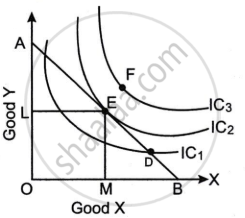Advertisements
Advertisements
Question
A consumer consumes only two goods A and B and is in equilibrium. Show that when price of good B falls, demand for B rises. Answer this question with the help of utility analysis
Solution
Utility Analysis:
The consumer reaches equilibrium only if the following condition is satisfied
`(MU_A)/P_A=(MU_B)/P_B`
Give that the utility received from each additional units of money spent on both the goods should be equal. The marginal utility of the amount spent on good A is equal to the marginal utility of the amount spent on good B and also equal to the marginal utility of money.
`(MU_A)/P_A=(MU_B)/P_B=MU_m`
if the priceof good B falls in relation to good A, the consumerwillbuymoreof good B.
`(MU_B)/(P_B)>(MU_A)/P_A=MU_m`
The consumption of good B will tend to increase till the equality is established between the marginal utilities of both the good become equal to the marginal utility of money.
APPEARS IN
RELATED QUESTIONS
A Consumer consumes only two goods X and Y. Marginal utilities of X and Y is 4 and 5 respectively. The prices of X and Y are Rs 4 per unit and Rs 5 per unit respectively. Is the consumer in equilibrium? What will be the further reaction of the consumer? Explain.
Given the price of a good, how does a consumer decide as to how much of the good to buy?
A consumer consumes only two goods X and Y. If marginal utilities of X and Y are 4 and 5 respectively, and if price of X is Rs 5 per unit and that of Y is Rs 4 per unit is the consumer in equilibrium? What will be further reaction of the consumer? Explain.
A consumer consumes only two goods X and Y both priced at Rs 3 per unit. If the consumer chooses a combination of these two goods with Marginal Rate of Substitution equal to 3, is the consumer in equilibrium? Give reasons. What will a rational consumer do in this situation? Explain
A consumer consumes only two goods X and Y whose prices are Rs 4 and Rs 5 per unit respectively. If the consumer chooses a combination of the two goods with marginal utility of X equal to 5 and that of Y equal to 4, is the consumer in equilibrium? Give reason. What will a rational consumer do in this situation? Use utility analysis.
A consumer consumes only two goods, each priced at Rupee one per unit. If the consumer chooses a combination of the two goods with Marginal Rate of Substitution equal to 2, is the consumer in equilibrium? Give reasons. Explain what will a rational consumer do in this situation.
A consumer consumes only two goods X and Y whose prices are Rs 2 and Rs 1 per unit respectively. It the consumer chooses a combination of the two goods with marginal utility of X being 4 and that of Y also being 4, is the consumer in equilibrium ?Give reasons. Explain what will a rational consumer do in this situation. Use Marginal Utility Analysis.
If equilibrium price of a good is greater than its market price, explain all the changes that will take place in the market. Use diagram.
How does the equilibrium price of a ‘normal’ commodity change when income of its buyers falls? Explain the chain effects.
What are the conditions of consumer’s equilibrium under the indifference curve approach? What changes will take place if the conditions are not fulfilled to reach equilibrium?
What can lead to change in budget set?
Identify the correctly matched pair from Column A to that of Column B:
| Column A | Column B | ||
| (1) | Investment Multiplier | (a) | C + I + G + (X − M) |
| (2) | Marginal Propensity to Consume | (b) | `(ΔC)/(ΔY)` |
| (3) | Marginal Propensity to Save | (c) | `(ΔI)/(ΔY)` |
| (4) | Aggregate Demand | (d) | `(ΔS)/(ΔY)` |
What is the saturation point?
With the help of a diagram, explain how the consumer will attain equilibrium on the consumption of a single commodity at a given price.
Refer to the diagram given below and answer the questions that follow.

- What does the line AB represent? Why is the line AB negatively sloped? (2)
- At which one of the given points, D, E and F, will the consumer attain equilibrium? Explain. (2)
- Briefly explain why the consumer is not in equilibrium at the other two points. (2)
